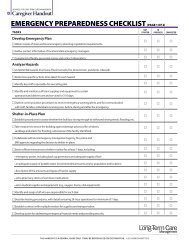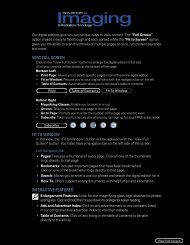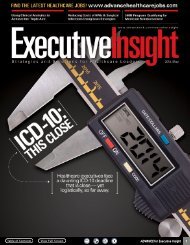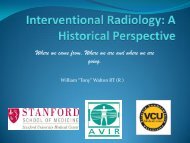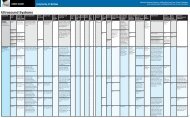1 ADVANCE for Executive Insight
1 ADVANCE for Executive Insight
1 ADVANCE for Executive Insight
- No tags were found...
Create successful ePaper yourself
Turn your PDF publications into a flip-book with our unique Google optimized e-Paper software.
CIO Perspective<br />
Extensive planning in the selection and implementation<br />
of IT projects can result in measurable benefits,<br />
but organizations must stay focused on true<br />
drivers <strong>for</strong> technology implementation in order to<br />
avoid ‘paper benefits.’<br />
sion assessment. At the onset of a new clinical<br />
system implementation, the nursing staff identified<br />
issues with the time required to document<br />
an admission assessment. Time studies<br />
conducted to validate anecdotal observations<br />
showed that the average admission assessment<br />
took 45 minutes. Nursing leadership felt that<br />
improved technology should reduce this timeframe<br />
and established that objective as a project<br />
success metric.<br />
After working with IT staff and the vendor,<br />
the nursing team felt that the documentation<br />
time could be reduced by 15 minutes using<br />
the new system. A multidisciplinary team including<br />
IT, nursing, ancillary clinical areas and<br />
others met to review the assessment process.<br />
Problem lists were consolidated and streamlined.<br />
Documentation tools were revised and<br />
mobile carts were introduced to permit bedside<br />
documentation.<br />
The result of this work was a reduction in the<br />
average time to document an admission assessment<br />
from 45 minutes to 27 minutes. Certainly,<br />
the outcome was positive and the goal was attained,<br />
but did the hospital see value from this<br />
increased efficiency? The math shows us that<br />
if the hospital admits 100 patients per day on<br />
average, the annual time savings amounts to almost<br />
11,000 hours or nearly 5 full time equivalent<br />
positions.<br />
Un<strong>for</strong>tunately, this is ‘marketing math’ and<br />
often does not translate to the ability to reduce<br />
staffing levels since small time savings may be<br />
difficult to aggregate effectively. The lesson<br />
learned was to ensure that the true intended<br />
value of any measureable benefit is understood<br />
and that metrics are set appropriately.<br />
To be sure, the time savings had benefits in improved<br />
documentation and enhanced nursing<br />
satisfaction, but those are difficult to translate<br />
to hard value.<br />
Barcoded med administration implemented<br />
to improve patient safety and reduce<br />
documentation time. The introduction of barcoding<br />
to the medication administration process<br />
has clear benefits in terms of the reduction<br />
in avoidable medication errors. Additionally,<br />
vendors also made claims that their systems<br />
would improve nursing workflow and enhance<br />
medication charge capture.<br />
While the rationale <strong>for</strong> implementing this<br />
technology is grounded firmly in patient safety,<br />
the organization conducted audits of medication<br />
charges and found that nurses were often<br />
double documenting medications. Rather than<br />
doing all documentation online, some RNs were<br />
documenting on paper in real-time and going<br />
back later in the shift to document electronically.<br />
The audits found that the nurses documented<br />
100 percent on paper, but failed to complete<br />
the electronic documentation 3.7 percent of the<br />
time. Since the medication charges flow from the<br />
electronic documentation, the resulting gap was<br />
an obvious improvement opportunity.<br />
A new process was streamlined in that documentation<br />
would take place in real-time at the<br />
bedside. Mobile carts with computers and lockable<br />
medication drawers were introduced to<br />
enable nurses to bring the medication and documentation<br />
system to the bedside. Documentation<br />
at the bedside was a significant disruption to<br />
nursing workflow and initially slowed down the<br />
nursing staff. However, by working closely with<br />
nursing leadership, the use of barcoding was<br />
standardized and the result was better charge<br />
capture without loss of nursing productivity.<br />
Evaluating Workflows<br />
Incentives are an excellent inducement to implement<br />
or upgrade clinical systems. However,<br />
clinical system implementations are complex<br />
and rushing through them can ultimately result<br />
in negative impacts. Carefully consider what<br />
efficiencies your organization is attempting to<br />
achieve by implementing new technology. Ensure<br />
that the measures are clear and translate directly<br />
to the desired benefits as in the case of time<br />
savings and FTE reductions. Evaluate workflows<br />
and processes carefully to make changes that are<br />
aligned with the flow of the new system. Proper<br />
planning will provide strong and lasting benefits<br />
to the organization.<br />
30 <strong>ADVANCE</strong> <strong>for</strong> <strong>Executive</strong> <strong>Insight</strong>



